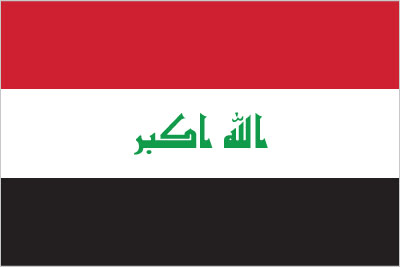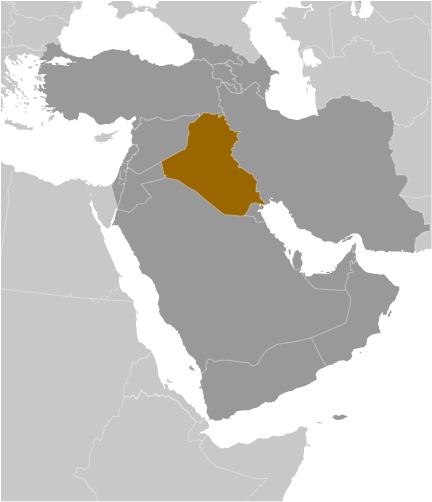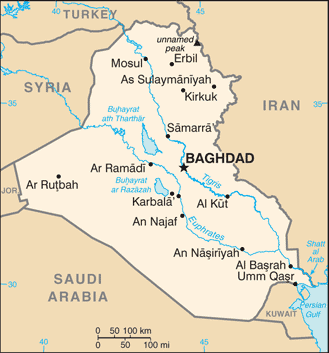|
Economy - overview:
|

|
|
An improving security environment and foreign investment are helping to spur economic activity, particularly in the energy, construction, and retail sectors. Broader economic development, long-term fiscal health, and sustained improvements in the overall standard of living still depend on the central government passing major policy reforms. Iraq's largely state-run economy is dominated by the oil sector, which provides more than 90% of government revenue and 80% of foreign exchange earnings. Iraq in 2012 boosted oil exports to a 30-year high of 2.6 million barrels per day, a significant increase from Iraq's average of 2.2 million in 2011. Government revenues increased as global oil prices remained persistently high for much of 2012. Iraq's contracts with major oil companies have the potential to further expand oil exports and revenues, but Iraq will need to make significant upgrades to its oil processing, pipeline, and export infrastructure to enable these deals to reach their economic potential. The Iraqi Kurdistan Region's (IKR) autonomous Kurdistan Regional Government (KRG) passed its own oil law in 2007, and has directly signed about 50 contracts to develop IKR energy reserves. The federal government has disputed the legal authority of the KRG to conclude most of these contracts, some of which are also in areas with unresolved administrative boundaries in dispute between the federal and regional government. Iraq is making slow progress enacting laws and developing the institutions needed to implement economic policy, and political reforms are still needed to assuage investors' concerns regarding the uncertain business climate, which may have been harmed by the November 2012 standoff between Baghdad and Erbil and the removal of the Central Bank Governor in October 2012. The government of Iraq is eager to attract additional foreign direct investment, but it faces a number of obstacles including a tenuous political system and concerns about security and societal stability. Rampant corruption, outdated infrastructure, insufficient essential services, skilled labor shortages, and antiquated commercial laws stifle investment and continue to constrain growth of private, nonoil sectors. Iraq is considering a package of laws to establish a modern legal framework for the oil sector and a mechanism to equitably divide oil revenues within the nation, although these reforms are still under contentious and sporadic negotiation. Under the Iraqi Constitution, some competencies relevant to the overall investment climate are either shared by the federal government and the regions or are devolved entirely to the regions. Investment in the IKR operates within the framework of the Kurdistan Region Investment Law (Law 4 of 2006) and the Kurdistan Board of Investment, which is designed to provide incentives to help economic development in areas under the authority of the KRG. Inflation has remained under control since 2006 as security improved. However, Iraqi leaders remain hard pressed to translate macroeconomic gains into an improved standard of living for the Iraqi populace. Unemployment remains a problem throughout the country despite a bloated public sector. Encouraging private enterprise through deregulation would make it easier for Iraqi citizens and foreign investors to start new businesses. Rooting out corruption and implementing reforms - such as restructuring banks and developing the private sector - would be important steps in this direction.
|
|
|
GDP (purchasing power parity):
|

|
|
$155.4 billion (2012 est.)
country comparison to the world: 61
$141 billion (2011 est.)
$129.6 billion (2010 est.)
note:
data are in 2012 US dollars
|
|
|
GDP (official exchange rate):
|

|
|
$130.6 billion (2012 est.)
|
|
|
GDP - real growth rate:
|

|
|
10.2% (2012 est.)
country comparison to the world: 8
8.9% (2011 est.)
3% (2010 est.)
|
|
|
GDP - per capita (PPP):
|

|
|
$4,600 (2012 est.)
country comparison to the world: 162
$4,300 (2011 est.)
$4,000 (2010 est.)
note:
data are in 2012 US dollars
|
|
|
GDP - composition by sector:
|

|
|
agriculture: 8.7%
industry:
63.8%
services:
25.1% (2012 est.)
|
|
|
Labor force:
|

|
|
8.9 million (2010 est.)
country comparison to the world: 54
|
|
|
Labor force - by occupation:
|

|
|
agriculture: 21.6%
industry:
18.7%
services:
59.8% (2008 est.)
|
|
|
Unemployment rate:
|

|
|
16% (2012 est.)
country comparison to the world: 150
15% (2010 est.)
|
|
|
Population below poverty line:
|

|
|
25% (2008 est.)
|
|
|
Household income or consumption by percentage share:
|

|
|
lowest 10%: 3.6%
highest 10%:
25.7% (2007 est.)
|
|
|
Investment (gross fixed):
|

|
|
10.1% of GDP (2011 est.)
country comparison to the world: 147
|
|
|
Budget:
|

|
|
revenues: $104.4 billion
expenditures:
$98.49 billion (2012 est.)
|
|
|
Taxes and other revenues:
|

|
|
79.9% of GDP (2012 est.)
country comparison to the world: 1
|
|
|
Budget surplus (+) or deficit (-):
|

|
|
4.5% of GDP (2012 est.)
country comparison to the world: 15
|
|
|
Inflation rate (consumer prices):
|

|
|
6.4% (2012 est.)
country comparison to the world: 169
5.6% (2011 est.)
|
|
|
Central bank discount rate:
|

|
|
6% (December 2012)
country comparison to the world: 61
6% (December 2011)
|
|
|
Commercial bank prime lending rate:
|

|
|
14.13% (31 December 2011 est.)
country comparison to the world: 54
14.35% (31 December 2010 est.)
|
|
|
Stock of narrow money:
|

|
|
$62.19 billion (31 December 2012 est.)
country comparison to the world: 43
$53.52 billion (31 December 2011 est.)
|
|
|
Stock of broad money:
|

|
|
$71.48 billion (31 December 2012 est.)
country comparison to the world: 61
$61.81 billion (31 December 2011 est.)
|
|
|
Stock of domestic credit:
|

|
|
$1.779 billion (31 December 2011 est.)
country comparison to the world: 141
$1.727 billion (31 December 2010 est.)
|
|
|
Market value of publicly traded shares:
|

|
|
$4 billion (9 December 2011)
country comparison to the world: 93
$2.6 billion (31 July 2010)
$2 billion (31 July 2009 est.)
|
|
|
Agriculture - products:
|

|
|
wheat, barley, rice, vegetables, dates, cotton; cattle, sheep, poultry
|
|
|
Industries:
|

|
|
petroleum, chemicals, textiles, leather, construction materials, food processing, fertilizer, metal fabrication/processing
|
|
|
Industrial production growth rate:
|

|
|
4.8% (2010 est.)
country comparison to the world: 64
|
|
|
Current account balance:
|

|
|
$20.63 billion (2012 est.)
country comparison to the world: 17
$21.68 billion (2011 est.)
|
|
|
Exports:
|

|
|
$88.27 billion (2012 est.)
country comparison to the world: 44
$79.68 billion (2011 est.)
|
|
|
Exports - commodities:
|

|
|
crude oil 84%, crude materials excluding fuels, food and live animals
|
|
|
Exports - partners:
|

|
|
India 22.5%, US 22.3%, China 13.4%, South Korea 11.7%, Japan 4.8%, Netherlands 4.3% (2011)
|
|
|
Imports:
|

|
|
$56.89 billion (2012 est.)
country comparison to the world: 52
$47.8 billion (2011 est.)
|
|
|
Imports - commodities:
|

|
|
food, medicine, manufactures
|
|
|
Imports - partners:
|

|
|
Turkey 25.3%, Syria 18.3%, China 11.7%, US 7.4%, South Korea 4.7% (2011)
|
|
|
Reserves of foreign exchange and gold:
|

|
|
$61.84 billion (31 December 2012 est.)
country comparison to the world: 32
$58.96 billion (31 December 2011 est.)
|
|
|
Debt - external:
|

|
|
$50.26 billion (31 December 2012 est.)
country comparison to the world: 57
$50.79 billion (31 December 2011 est.)
|
|
|
Exchange rates:
|

|
|
Iraqi dinars (IQD) per US dollar -
1,166 (2012 est.)
1,170 (2011 est.)
1,170 (2010 est.)
1,170 (2009)
1,176 (2008)
|
|
|
Fiscal year:
|

|
|
calendar year
|
|
|
|





 )
)



